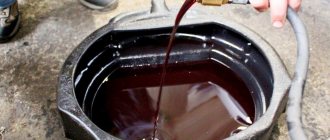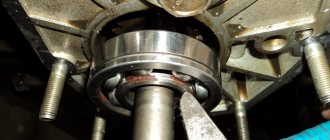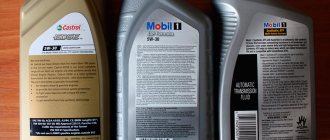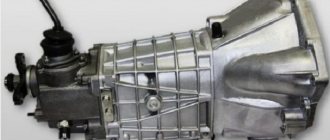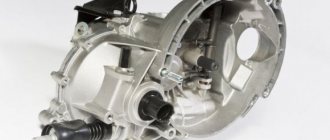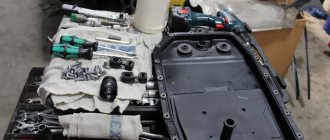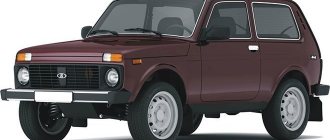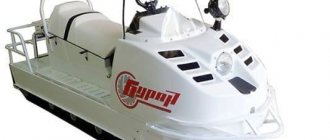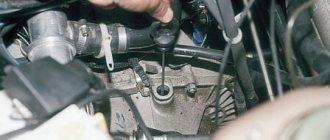Buran is a family of universal snowmobiles of Soviet and Russian production, launched in 1973. Initially, snowmobiles were produced in Rybinsk, and now the company is called Russian Mechanics (a subsidiary of NPO Saturn). The early line of "Buran" is represented by the models "Bars" (1982), "Arctic" (1990), "Buran-M" (2002), as well as Buran with a 4-stroke Briggs & Stratton engine (an extremely rare model introduced in 2008).
The modern line includes models “Buran-A” (with an electric starter), “Buran-ADE” (an extended snowmobile with an electric starter and a spotlight), “Buran-4T” (with a 4-stroke 29-horsepower Kohler engine) and “Buran Leader" (released in 2021, the most modern of all Burans).
Buran snowmobile engine - how much oil to fill
First generation from 1973
The Buran snowmobile is based on one rotating ski and double tracks. This arrangement provides a large supporting area with fairly small dimensions of the snowmobile. Thanks to this, it is possible to overcome the forest thicket, ravines and small undergrowth. In addition, it is possible to tow trailers up to 250 kg due to the large final drive ratio and special engine settings, which can develop maximum torque at low speeds.
Thanks to the low compression ratio, the Buran engine consumes inexpensive gasoline A-76, AI-80 or gas condensate. The most expensive versions can be equipped with an electric starter. A two-seater snowmobile with an RMZ-640/Kohler engine develops a maximum power of 34 hp. With. and accelerates to 55 km/h. The gas tank volume is 28 liters, and the snowmobile weighs 275 kg.
Gasoline engines
- Two-stroke, RMZ-640 with a volume of 0.635 liters (34 hp), oil volume - 0.25 liters per 10 liters of gasoline (proportion 1/40), specifications: API-TC, JASO-FB/FC, ISO EGB/EGC
- Four-stroke, Kohler 725cc. cm (27 hp), oil volume - 1.6 liters, specifications: API-TC, JASO-FB/FC, ISO EGB/EGC
"Buran" and "Shuttle": such different twins
When you look at photographs of the winged spacecraft "Buran" and "Shuttle", you may get the impression that they are quite identical. At least there shouldn’t be any fundamental differences. Despite their external similarity, these two space systems are still fundamentally different.
Shuttle and Buran
"Shuttle"
The Shuttle is a reusable transport spacecraft (MTSC). The ship has three liquid rocket engines (LPREs) powered by hydrogen. The oxidizing agent is liquid oxygen. Entering low-Earth orbit requires a huge amount of fuel and oxidizer. Therefore, the fuel tank is the largest element of the Space Shuttle system. The spacecraft is located on this huge tank and is connected to it by a system of pipelines through which fuel and oxidizer are supplied to the Shuttle engines.
And still, three powerful engines of a winged ship are not enough to go into space. Attached to the central tank of the system are two solid propellant boosters - the most powerful rockets in human history to date. The greatest power is needed precisely at launch, in order to move a multi-ton ship and lift it to the first four and a half dozen kilometers. Solid rocket boosters take on 83% of the load.
Another Shuttle takes off
At an altitude of 45 km, the solid fuel boosters, having exhausted all the fuel, are separated from the ship and splashed down in the ocean using parachutes. Further, to an altitude of 113 km, the shuttle rises with the help of three rocket engines. After the tank is separated, the ship flies for another 90 seconds by inertia and then, for a short time, two orbital maneuvering engines running on self-igniting fuel are turned on. And the shuttle enters operational orbit. And the tank enters the atmosphere, where it burns up. Some of its parts fall into the ocean.
Solid propellant booster department
Orbital maneuvering engines are designed, as their name suggests, for various maneuvers in space: for changing orbital parameters, for mooring to the ISS or to other spacecraft located in low-Earth orbit. So the shuttles visited the Hubble orbital telescope several times to carry out maintenance.
And finally, these engines serve to create a braking impulse when returning to Earth.
The orbital stage is made according to the aerodynamic design of a tailless monoplane with a low-lying delta-shaped wing with a double swept leading edge and with a vertical tail of the usual design. For control in the atmosphere, a two-section rudder on the fin (there is also an air brake), elevons on the trailing edge of the wing and a balancing flap under the rear fuselage are used. The landing gear is retractable, three-post, with a nose wheel.
Length 37.24 m, wingspan 23.79 m, height 17.27 m. Dry weight of the device is about 68 tons, takeoff - from 85 to 114 tons (depending on the mission and payload), landing with return cargo on on board - 84.26 tons.
The most important feature of the airframe design is its thermal protection.
In the most heat-stressed areas (design temperature up to 1430º C), a multilayer carbon-carbon composite is used. There are not many such places, these are mainly the fuselage toe and the leading edge of the wing. The lower surface of the entire apparatus (heating from 650 to 1260º C) is covered with tiles made of a material based on quartz fiber. The top and side surfaces are partially protected by low-temperature insulation tiles - where the temperature is 315–650º C; in other places where the temperature does not exceed 370º C, felt material coated with silicone rubber is used.
The total weight of thermal protection of all four types is 7164 kg.
The orbital stage has a double-deck cabin for seven astronauts.
Upper deck of the shuttle cabin
In the case of an extended flight program or during rescue operations, up to ten people can be on board the shuttle. In the cabin there are flight controls, work and sleeping places, a kitchen, a pantry, a sanitary compartment, an airlock, operations and payload control posts, and other equipment. The total pressurized volume of the cabin is 75 cubic meters. m, the life support system maintains a pressure of 760 mm Hg. Art. and temperature in the range of 18.3 – 26.6º C.
This system is made in an open version, that is, without the use of air and water regeneration. This choice was due to the fact that the duration of the shuttle flights was set at seven days, with the possibility of increasing it to 30 days using additional funds. With such insignificant autonomy, installing regeneration equipment would mean an unjustified increase in weight, power consumption and complexity of on-board equipment.
The supply of compressed gases is sufficient to restore the normal atmosphere in the cabin in the event of one complete depressurization or to maintain a pressure in it of 42.5 mm Hg. Art. for 165 minutes with the formation of a small hole in the housing shortly after launch.
The cargo compartment measures 18.3 x 4.6 m and has a volume of 339.8 cubic meters. m is equipped with a “three-armed” manipulator 15.3 m long. When the compartment doors are opened, the radiators of the cooling system are rotated into the working position along with them. The reflectivity of radiator panels is such that they remain cool even when the sun is shining on them.
What the Space Shuttle can do and how it flies
If we imagine the assembled system flying horizontally, we see the external fuel tank as its central element; An orbiter is docked to it on top, and accelerators are on the sides. The total length of the system is 56.1 m, and the height is 23.34 m. The overall width is determined by the wingspan of the orbital stage, that is, 23.79 m. The maximum launch mass is about 2,041,000 kg.
It is impossible to speak so unambiguously about the size of the payload, since it depends on the parameters of the target orbit and on the launch point of the ship. Let's give three options. The Space Shuttle system is capable of launching: – 29,500 kg when launched east from Cape Canaveral (Florida, east coast) into an orbit with an altitude of 185 km and an inclination of 28º; – 11,300 kg when launched from the Space Flight Center. Kennedy into an orbit with an altitude of 500 km and an inclination of 55º; – 14,500 kg when launched from Vandenberg Air Force Base (California, west coast) into a polar orbit at an altitude of 185 km.
Two landing strips were equipped for the shuttles. If the shuttle landed far from the spaceport, it returned home riding on a Boeing 747
Boeing 747 carries the shuttle to the spaceport
A total of five shuttles were built (two of them died in disasters) and one prototype.
During development, it was envisaged that the shuttles would make 24 launches per year, and each of them would make up to 100 flights into space. In practice, they were used much less - by the end of the program in the summer of 2011, 135 launches had been made, of which Discovery - 39, Atlantis - 33, Columbia - 28, Endeavor - 25, Challenger - 10 .
The shuttle crew consists of two astronauts - the commander and the pilot. The largest shuttle crew was eight astronauts (Challenger, 1985).
Soviet reaction to the creation of the Shuttle
The development of the shuttle made a great impression on the leaders of the USSR. It was believed that the Americans were developing an orbital bomber armed with space-to-ground missiles. The huge size of the shuttle and its ability to return cargo of up to 14.5 tons to Earth were interpreted as a clear threat of theft of Soviet satellites and even Soviet military space stations such as Almaz, which flew in space under the name Salyut. These estimates were erroneous, since the United States abandoned the idea of a space bomber back in 1962 due to the successful development of the nuclear submarine fleet and ground-based ballistic missiles.
The Soyuz could easily fit in the Shuttle's cargo bay.
Soviet experts could not understand why 60 shuttle launches per year were needed - one launch per week! Where would the many space satellites and stations for which the Shuttle would be needed come from? The Soviet people, living within a different economic system, could not even imagine that NASA management, strenuously pushing the new space program in the government and Congress, was driven by the fear of being left without a job. The lunar program was nearing completion and thousands of highly qualified specialists found themselves out of work. And, most importantly, the respected and very well-paid leaders of NASA faced the disappointing prospect of parting with their lived-in offices.
Therefore, an economic justification was prepared on the great financial benefits of reusable transport spacecraft in the event of abandonment of disposable rockets. But it was absolutely incomprehensible to the Soviet people that the president and Congress could spend national funds only with great regard for the opinions of their voters. In connection with this, the opinion reigned in the USSR that the Americans were creating a new spacecraft for some future unknown tasks, most likely military.
Reusable spacecraft "Buran"
In the Soviet Union, it was initially planned to create an improved copy of the Shuttle - the OS-120 orbital aircraft, weighing 120 tons. (The American shuttle weighed 110 tons when fully loaded). Unlike the Shuttle, it was planned to equip the Buran with an ejection cabin for two pilots and turbojet engines for landing at the airfield.
The leadership of the USSR armed forces insisted on almost complete copying of the shuttle. By this time, Soviet intelligence had managed to obtain a lot of information on the American spacecraft. But it turned out that not everything is so simple. Domestic hydrogen-oxygen liquid rocket engines turned out to be larger in size and heavier than American ones. In addition, they were inferior in power to overseas ones. Therefore, instead of three liquid rocket engines, it was necessary to install four. But on an orbital plane there was simply no room for four propulsion engines.
For the shuttle, 83% of the load at launch was carried by two solid fuel boosters. The Soviet Union failed to develop such powerful solid-fuel missiles. Missiles of this type were used as ballistic carriers of sea- and land-based nuclear charges. But they fell very, very far short of the required power. Therefore, Soviet designers had the only option - to use liquid rockets as accelerators. Under the Energia-Buran program, very successful kerosene-oxygen RD-170s were created, which served as an alternative to solid fuel accelerators.
The very location of the Baikonur Cosmodrome forced designers to increase the power of their launch vehicles. It is known that the closer the launch site is to the equator, the larger the load the same rocket can launch into orbit. The American cosmodrome at Cape Canaveral has a 15% advantage over Baikonur! That is, if a rocket launched from Baikonur can lift 100 tons, then when launched from Cape Canaveral it will launch 115 tons into orbit!
Geographical conditions, differences in technology, characteristics of the created engines and different design approaches all had an impact on the appearance of the Buran. Based on all these realities, a new concept and a new orbital vehicle OK-92, weighing 92 tons, were developed. Four oxygen-hydrogen engines were transferred to the central fuel tank and the second stage of the Energia launch vehicle was obtained. Instead of two solid fuel boosters, it was decided to use four kerosene-oxygen liquid fuel rockets with four-chamber RD-170 engines. Four-chamber means with four nozzles. A large-diameter nozzle is extremely difficult to manufacture. Therefore, designers go to complicate and make the engine heavier by designing it with several smaller nozzles. As many nozzles as there are combustion chambers with a bunch of fuel and oxidizer supply pipelines and all the “moorings”. This connection was made according to the traditional, “royal” scheme, similar to “unions” and “Easts”, and became the first stage of “Energy”.
"Buran" in flight
The Buran winged ship itself became the third stage of the launch vehicle, like the same Soyuz. The only difference is that the Buran was located on the side of the second stage, and the Soyuz at the very top of the launch vehicle. Thus, the classic scheme of a three-stage disposable space system was obtained, with the only difference being that the orbital ship was reusable.
Reusability was another problem of the Energia-Buran system. For the Americans, the shuttles were designed for 100 flights. For example, orbital maneuvering engines could withstand up to 1000 activations. After preventative maintenance, all elements (except for the fuel tank) were suitable for launch into space.
The solid fuel accelerator was selected by a special vessel
Solid fuel boosters were lowered by parachute into the ocean, picked up by special NASA vessels and delivered to the manufacturer's plant, where they underwent maintenance and were filled with fuel. The Shuttle itself also underwent thorough inspection, maintenance and repair.
Defense Minister Ustinov, in an ultimatum, demanded that the Energia-Buran system be as reusable as possible. Therefore, designers were forced to address this problem. Formally, the side boosters were considered reusable, suitable for ten launches. But in fact, things did not come to this for many reasons. Take, for example, the fact that American boosters splashed into the ocean, and Soviet boosters fell in the Kazakh steppe, where landing conditions were not as benign as warm ocean waters. And a liquid rocket is a more delicate creation. than solid fuel."Buran" was also designed for 10 flights.
In general, a reusable system did not work out, although the achievements were obvious. The Soviet orbital ship, freed from large propulsion engines, received more powerful engines for maneuvering in orbit. Which, if used as a space “fighter-bomber,” gave it great advantages. And plus turbojet engines for flight and landing in the atmosphere. In addition, a powerful rocket was created with the first stage using kerosene fuel, and the second using hydrogen. This is exactly the kind of rocket the USSR needed to win the lunar race. “Energia” in its characteristics was almost equivalent to the American Saturn 5 rocket that sent Apollo 11 to the Moon.
"Buran" has a great external resemblance to the American "Shuttle". The ship is built according to the design of a tailless aircraft with a delta wing of variable sweep, and has aerodynamic controls that operate during landing after returning to dense layers of the atmosphere - rudder and elevons. He was capable of making a controlled descent in the atmosphere with a lateral maneuver of up to 2000 kilometers.
The length of the Buran is 36.4 meters, the wingspan is about 24 meters, the height of the ship on the chassis is more than 16 meters. The launch weight of the ship is more than 100 tons, of which 14 tons are fuel. A sealed all-welded cabin for the crew and most of the equipment for flight support as part of the rocket and space complex is inserted into the bow compartment, autonomously of flight in orbit, descent and landing. Cabin volume is more than 70 cubic meters.
When returning to the dense layers of the atmosphere, the most heat-stressed areas of the ship's surface heat up to 1600 degrees, the heat reaching directly to the metal the personal design of the ship, should not exceed 150 degrees. Therefore, “Buran” was distinguished by powerful thermal protection, ensuring normal temperature conditions for the design of the ship when passing through dense layers of the atmosphere during landing.
The heat-protective coating of more than 38 thousand tiles is made of special materials: quartz fiber, high-temperature organic fibers, partly oc-based material new carbon. Ceramic armor has the ability to accumulate heat without letting it pass to the ship's hull. The total weight of this armor was about 9 tons.
The length of the cargo compartment of the Buran is about 18 meters. Its spacious cargo compartment could accommodate a payload weighing up to 30 tons. It was possible to place large-sized spacecraft there - large satellites, orbital station blocks. The landing weight of the ship is 82 tons.
"Buran" was equipped with all the necessary systems and equipment for both automatic and manned flight. These are navigation and control devices, radio and television systems, automatic thermal control devices, crew life support systems, and much, much more.
Cabin Buran
The main engine installation, two groups of engines for maneuvering, are located at the end of the tail compartment and in the front part of the hull.
In total, it was planned to build 5 orbital ships. In addition to “Buran,” “Storm” and almost half of “Baikal” were almost ready. Two more ships in the initial stages of production have not received names. The Energia-Buran system was unlucky - it was born at an unfortunate time for it. The USSR economy was no longer able to finance expensive space programs. And some kind of fate haunted the cosmonauts preparing for flights on the Buran. Test pilots V. Bukreev and A. Lysenko died in plane crashes in 1977, even before joining the cosmonaut group. In 1980, test pilot O. Kononenko died. 1988 took the lives of A. Levchenko and A. Shchukin. After the Buran flight, R. Stankevicius, the second pilot for the manned flight of the winged spacecraft, died in a plane crash. I. Volk was appointed the first pilot.
Buran was also unlucky. After the first and only successful flight, the ship was stored in a hangar at the Baikonur Cosmodrome. On May 12, 2002, the ceiling of the workshop in which the Buran and the Energia model were located collapsed. On this sad chord, the existence of the winged spaceship, which showed so much hope, ended.
After the collapse of the ceiling
Sources: https://timemislead.com/kosmonavtika/buran-i-shattl-takie-raznyie-bliznetsyi https://gunm.ru/news/spejs_shattl_kak_dostizhenie_tekhnicheskoj_mysli_chast_6_poslednjaja/2011-07-21-359 https://www.znanijamira. ru/publ/kosmos/korabli_mnogorazovogo_ispolzovanija_shattl_ssha_i_buran_sssr/39-1-0-1481
What kind of oil to pour into the Buran snowmobile engine
For the Buran snowmobile engine, mineral, semi-synthetic or synthetic motor oil with different viscosities is recommended. So, for cars of the first years of production, mineral water is suitable, and for newer models - semi-synthetic or synthetic. Official Buran dealers recommend the branded semi-synthetic oil Buran 2-T RM TU 0253-001-94265207-06 for two-stroke engines. For four-stroke engines, the best option is Liqui Moly Motoroil 0W-40. Engine oil must meet SAE 10W-40 and API-SH parameters.
What kind of oil to pour into the gearbox of a Buran snowmobile
Motorrad Gear Oil 75W-90 transmission fluid is suitable for the Buran snowmobile gearbox. This oil is made on a synthetic basis and has a low pour point of minus 54 degrees, which indicates a fairly large reserve of low-temperature properties. Motorrad Gear Oil 75W-90 is characterized by high resistance to oxidation, foaming and corrosion. Transmission oil for the Buran snowmobile gearbox must comply with SAE 80W/90 viscosity and API-GL-5 approval.
Peculiarities
"Buran" was built according to the "tailless" aerodynamic design and had a delta wing. Like its overseas counterparts, it was quite large: 36.4 m in length, wingspan - 24 m, launch weight - 105 tons. The spacious all-welded cabin could accommodate up to ten people.
One of the most important elements of the Buran design was thermal protection. In some places of the device during takeoff and landing, the temperature could reach 1430 ° C. Carbon-carbon composites, quartz fiber and felt materials were used to protect the ship and crew. The total weight of heat-protective materials exceeded 7 tons.
The large cargo compartment made it possible to take on board large cargo, for example, space satellites. To launch such devices into space, Buran could use a huge manipulator, similar to the one on board the shuttle. The total carrying capacity of the Buran was 30 tons.
Two stages were involved in the launch of the spacecraft. At the initial stage of the flight, four rockets with RD-170 liquid-fuel engines, the most powerful liquid-fuel engines ever created, undocked from the Buran. The thrust of the RD-170 was 806.2 tf, and its operating time was 150 s. Each such engine had four nozzles. The second stage of the ship consists of four RD-0120 liquid oxygen-hydrogen engines installed on the central fuel tank. The operating time of these engines reached 500 s. After the fuel was used up, the ship undocked from the huge tank and continued its flight independently. The shuttle itself can be considered the third stage of the space complex. In general, the Energia launch vehicle was one of the most powerful in the world, and had very great potential.
Structural and layout diagram of "Buran" / ©buran.ru/Alexey Mikheev, Vadim Lukashevich
Perhaps the main requirement for the Energia-Buran program was maximum reusability. And indeed: the only disposable part of this complex was supposed to be a giant fuel tank. However, unlike the engines of the American shuttles, which splashed down gently in the ocean, the Soviet boosters landed in the steppe near Baikonur, so reusing them was quite problematic.
Another feature of the Buran was that its propulsion engines were not part of the vehicle itself, but were located on the launch vehicle - or rather, on the fuel tank. In other words, all four RD-0120 engines burned up in the atmosphere, while the shuttle engines returned with it. In the future, Soviet designers wanted to make the RD-0120 reusable, and this would significantly reduce the cost of the Energia-Buran program. In addition, the ship was supposed to have two built-in jet engines for maneuvers and landing, but for its first flight the device was not equipped with them and was actually a “naked” glider. Like its American counterpart, the Buran could only land once - in case of an error there was no second chance.
The big advantage was that the Soviet concept made it possible to launch into orbit not only a ship, but also additional cargo weighing up to 100 tons. The domestic shuttle had some advantages over the shuttles. For example, it could carry up to ten people (versus seven crew members for the shuttle) and was able to spend more time in orbit - about 30 days, while the longest shuttle flight was only 17.
Unlike the shuttle, it had the Buran and a crew rescue system. At low altitude, the pilots could eject, and if an unforeseen situation occurred above, the ship would separate from the launch vehicle and land like an airplane.
©buran.ru/Vadim Lukashevich, Armin Schieb
